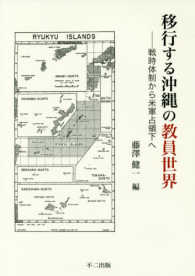- ホーム
- > 洋書
- > 英文書
- > Psychology
Full Description
The authors encourage an active approach to learning statistics through many in-depth activities that give students the opportunity to test or demonstrate their understanding of statistical concepts. The Second Edition is based on contemporary research on memory and the "testing effect" which requires students to answer questions to facilitate their long-term retention.
Contents
PrefaceAbout the Authors1 Introduction to Statistics and Frequency DistributionsHow to Be Successful in This CourseMath Skills Required in This CourseWhy Do You Have to Take Statistics?Statistics and the Helping ProfessionsHypothesis Testing, Effect Size, and Confidence IntervalsTesting Causal HypothesesPopulations and SamplesIndependent and Dependent VariablesScales of MeasurementDiscrete Versus Continuous VariablesGraphing DataShapes of DistributionsFrequency Distribution TablesSPSSOverview of the ActivityChapter 1 Practice Test2 Central TendencyCentral TendencyComputing the MeanFind the MedianFind the ModeSPSSOverview of the ActivityChapter 2 Practice Test3 VariabilityPopulation VariabilitySteps in Computing a Population's Standard DeviationSample VariabilitySPSSOverview of the ActivityChapter 3 Practice Test4 z Scoresz for a Single ScoreUsing X to Find Important "Cut Lines"z Scores and the Standard Normal CurveExample 1: Positive z ScoreExample 2: Negative z ScoreExample 3: Proportion Between Two z ScoresOverview of the ActivityChapter 4 Practice Test5 The Distribution of Sample Means and z for a Sample MeanSampling and Sampling ErrorDistribution of Sample Meansz for a Sample MeanExample: Computing and Interpreting the z for a Sample MeanExact Probabilities Versus Probability EstimatesOverview of the ActivitiesChapter 5 Practice Test6 Hypothesis Testing With z ScoresIntroduction to Hypothesis TestingHypothesis Testing With z for a Sample Mean Example (One-Tailed)What Does It Mean to Describe Something as "Statistically Significant"?Errors in Hypothesis TestingHypothesis Testing RulesWhat Is a p Value?Why Statisticians "Fail to Reject the Null" Rather Than "Accept the Null"Why Scientists Say "This Research Suggests" Rather Than "This Research Proves"Overview of the ActivitiesChapter 6 Practice Test7 Single-Sample t TestSingle-Sample t TestConceptual InformationOne-Tailed Single-Sample t Test ExampleTwo-Tailed Single-Sample t Test ExampleOther Alpha LevelsSPSSOverview of the ActivityChapter 7 Practice Test8 Estimation With Confidence IntervalsThree Statistical Procedures With Three Distinct PurposesLogic of Confidence IntervalsComputing a Confidence Interval for a Population MeanComputing Confidence Intervals for a Mean DifferenceReporting Confidence Intervals in APA StyleConfidence Intervals for Effect SizesInterpretations of Confidence IntervalsSPSSOverview of the ActivityChapter 8 Practice Test9 Related Samples t TestRepeated/Related Samples t TestLogic of the Single-Sample and Repeated/Related Samples t TestsRelated Samples t (Two-Tailed) ExampleRelated Samples t (One-Tailed) ExampleStatistical Results, Experimental Design, and Scientific ConclusionsSPSSOverview of the ActivitiesChapter 9 Practice Test10 Independent Samples t TestIndependent Samples tConceptual Formula for the Independent Samples tTwo-Tailed Independent t Test ExampleOne-Tailed Independent t Test ExampleOther Alpha LevelsSPSSOverview of the ActivitiesChapter 10 Practice Test11 One-Way Independent Samples ANOVAIndependent Samples ANOVAAn Example ANOVA ProblemAn Additional Note on ANOVAs: Family-Wise Error and Alpha InflationSPSSOverview of the ActivitiesChapter 11 Practice Test12 Two-Factor ANOVA or Two-Way ANOVAPurpose of the Two-Way ANOVADescribing Factorial DesignsLogic of the Two-Way ANOVAExample of a Two-Way ANOVASPSSOverview of the ActivitiesChapter 12 Practice Test13 Correlation and RegressionWhen to Use Correlations and What They Can Tell YouReview of z ScoresThe Logic of CorrelationDirection and Strength of Correlation CoefficientsComputational FormulasSpearman's (rs) CorrelationsUsing Scatterplots Prior to Correlation CoefficientsAlternative Use for CorrelationCorrelation and CausationHypothesis Testing With CorrelationTwo-Tailed Pearson's Correlation ExampleOne-Tailed Pearson's Correlation ExampleWhat If You Need to Do a Spearman's Correlation?Confidence IntervalsSPSSOverview of the ActivitiesChapter 13 Practice Test14 Goodness of Fit and Independence Chi-Square StatisticsOverview of Chi-SquareLogic of the Chi-Square TestComparing the Goodness-of-Fit Chi-Square and the Chi-Square for IndependenceGoodness-of-Fit Chi-Square ExampleChi-Square for IndependenceSPSSOverview of the ActivitiesChapter 14 Practice TestAppendicesAppendix AUnit Normal Table (z Table)Appendix BOne-Tailed Probabilities t TableTwo-Tailed Probabilities t TableAppendix CF Table (a = .05)F Table (a = .01)Appendix DThe Studentized Range Statistic (q) TableAppendix EOne-Tailed Pearson's Correlation TableTwo-Tailed Pearson's Correlation TableAppendix FSpearman's Correlation TableAppendix GFisher r to z TableAppendix HCritical Values for Chi-SquareAppendix IComputing SSs for Factorial ANOVAAppendix JChoosing Correct Test StatisticsIndex







